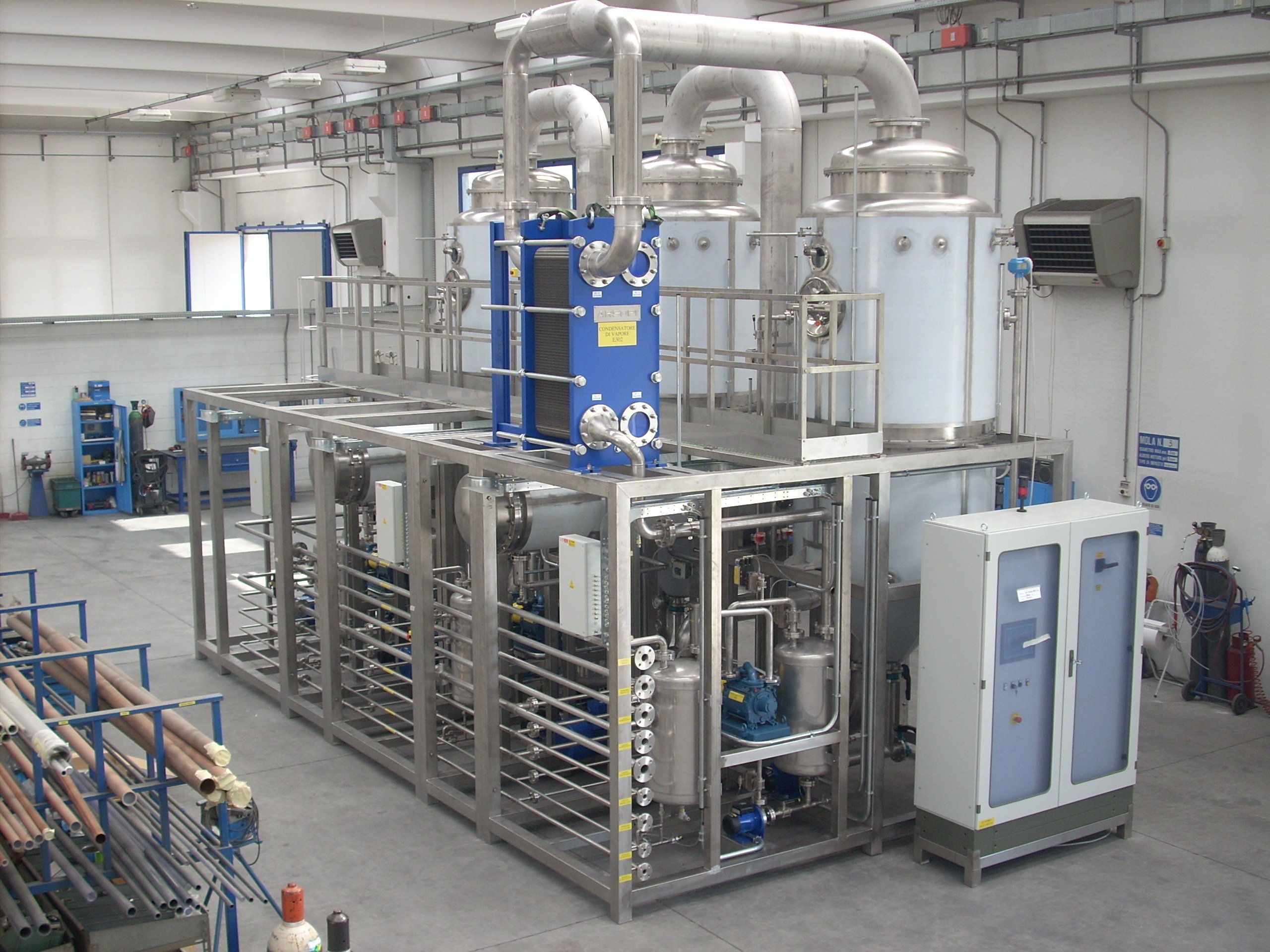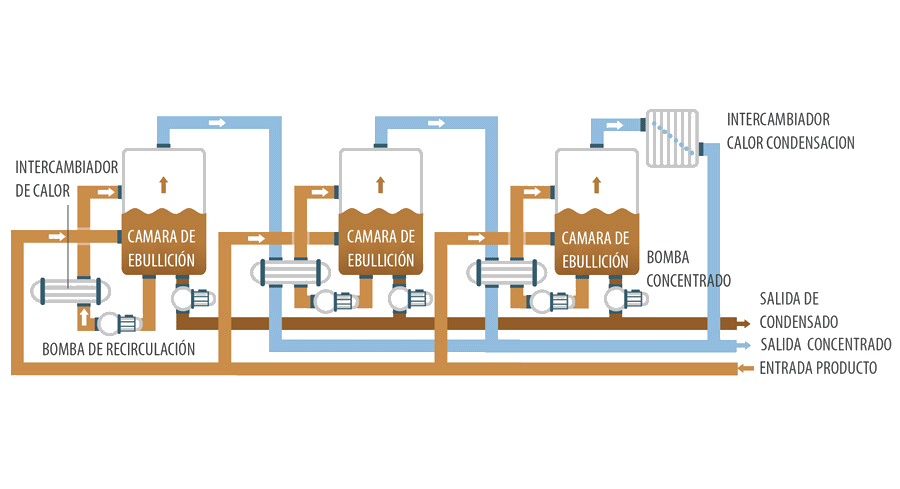Sections
- Role of vacuum evaporators in an industrial effluent treatment plant
- Basic operating principles of Vacuum Evaporation
- Advantages of vacuum evaporation
- Types of vacuum evaporators depending on the energy source
Role of vacuum evaporators in an industrial effluent treatment plant
Vacuum evaporators are a cornerstone of modern industrial effluent treatment plants, offering a sustainable and efficient solution for managing complex wastewater challenges. By enabling volume reduction, resource recovery, and compliance with stringent environmental standards, these systems not only enhance operational efficiency but also contribute to broader sustainability goals. For industries seeking to adopt innovative and responsible wastewater treatment practices, vacuum evaporators represent a transformative choice.
Industrial effluent treatment is a critical aspect of modern industrial operations. As industries strive to comply with stringent environmental regulations and adopt sustainable practices, advanced treatment technologies have become indispensable. Among these, vacuum evaporators stand out as a highly effective solution for managing complex wastewater challenges.
This article explores the pivotal role and numerous benefits of vacuum evaporators in industrial effluent treatment plants.
Basic operating principles of vacuum evaporation
Vacuum evaporators are specialized systems designed to treat industrial effluents by utilizing the principle of evaporation under reduced pressure. This process lowers the boiling point of liquids, enabling efficient separation of water from contaminants without the need for excessive heat.
To achieve the phase change that allows the separation of the solute and the solvent, heat must be supplied to the mixture so that the liquid part evaporates and separates from the solid part. This heat can be generated in several ways:
- Directly by heating a container that holds the sample.
- Indirectly using steam as a heat transfer agent: vacuum evaporation
In the case of vacuum evaporation, a boiler is used to heat water until it evaporates. This steam is directed to a chamber where it will transfer that heat to the mixture that is to be separated.
On the other hand, to facilitate the evaporation of the solvent, vacuum generating systems can be used, subjecting the mixture to be separated to pressures lower than atmospheric pressure. This reduces the boiling point of the liquids and also increases the efficiency of the heat transfer phenomenon in the system.
When considering the use of a thermal separation process for a specific liquid mixture, the following points must be taken into account:
- The thermal sensitivity of the solution.
- The potential corrosion to the materials.
- The concentration and other physical characteristics.
- The potential appearance of scaling.
Regarding the thermal sensitivity of the solution, it is noteworthy the importance of working at low temperatures in cases where the properties of the solution may be altered by temperature.
This is very common in protein elements, which can denature with increasing temperature. The separation by volatilization of the solvent to concentrate the solute allows the application of vacuum to thus lower the volatilization temperature of the solvent and eliminate the risk of altering the properties of the food solution.
Corrosion of the materials that make up the evaporator can occur if the feed liquid is considerably aggressive towards the materials from which the evaporator is constructed. Currently, all evaporators are built with stainless steel, graphite, nickel, copper, and some alloys with special resistance to corrosion, so the spectrum of potentially treatable solutions by thermal separation is very broad.
Advantages of vacuum evaporation
Separation by vacuum evaporation serves to separate incoming effluent into two parts: one part with water that has a low concentration of dissolved contaminants and another part with a liquid condensate with a high content of the same contaminants.
To achieve this, the water is transformed into vapor, separating it at that moment from the contaminating materials that are dissolved in it, and this vapor is transported to a chamber where it is cooled to reconcentrate the water free of contaminants.
Thus, this procedure is one of the most efficient for industrial effluent treatment, as it allows for the effective separation of contaminants found in water based on the relatively low volatility of salts compared to water. Thanks to evaporation, substances such as dissolved solids can be eliminated, although compounds with a boiling point similar to or close to that of water, such as alcohol, may not be separated.
It is an essential technology for companies that want to implement a zero discharge system.
After an evaporation process, very high percentages of distilled water (95%) are obtained and a very small amount of reject (5%) to be managed. This reject is so small due to the high concentration of waste achieved in the process. Thanks to this, industries that need to treat medium and large flows can benefit from significant savings, as the volume of waste that must be sent for management is considerably reduced.
It is also a very suitable technology for producing high-quality water that many industries need to incorporate into their production processes.
Advantages of vacuum evaporators:
- High quality of the distillate.
- It is possible to recover up to 97% of clean water.
- Allows for the reuse of treated water.
- High reduction and concentration of the liquid waste that will require further treatment or disposal. This minimizes waste management costs and environmental impact.
- Can manage the most complex effluents.
- Facilitating Zero Liquid Discharge. Vaccum evaporators are integral to achieving ZLD.
- Low electricity consumption.
- Flexible and compact design of the machines.
- Operational reliability
- It is an easy-to-use technology and requires little maintenance.
Another notable aspect of vacuum evaporators is their versatility and the large number of occasions they can be applied. Vacuum evaporators are especially suitable for the separation and treatment of:
- Dissolved hydrocarbons in contaminated waters.
- Oily emulsions.
- Landfill leachate treatment.
- Galvanic metal cleaning rinse waters.
- Degreasing waters.
- Waters with a high content of oily substances.
- Waters with a high content of heavy metals.
- Waters with a high content of dissolved salts.
It is common to complete a vacuum evaporation process with other wastewater treatment technologies, which can be applied beforehand (membranes, physicochemical processes, etc.), subjecting the effluent to a pretreatment that facilitates the evaporation process, or afterwards if a greater concentrate is desired. In this second case, the most suitable technology is crystallizers, which can be used in two ways:
- Crystallizer used as a final stage after a classic evaporation process.
- Evaporator and crystallizer integrated into a single unit that combines both processes. This solution is suitable for small and difficult-to-treat flows.
Depending on the composition of the wastewater to be treated, an evaporative crystallization process allows for the separation of its components and the recovery of secondary products, which can be reused or sold. This happens with oil from oily waters, which can be sold as a secondary product with a water content of less than 5%, or with the recovery of aluminum hydroxide, which can later be used as a chemical product, to name a few examples.
Types of vacuum evaporators depending on the energy source
Depending on the energy source that is being used, vacuum evaporators can be clasified in two types:
Thermal evaporators
These systems rely on external heat sources, such as steam or hot water, to drive the evaporation process.
Thermal evaporators are highly efficient in treating large volumes of wastewater and are often used in industries with access to surplus heat. They are particularly effective in concentrating high-salinity effluents and recovering heat-sensitive substances.
The integration of thermal evaporators with heat recovery systems further enhances their energy efficiency, making them a cost-effective choice for many industrial applications.
Thermal evaporators operate at temperatures that range between 90º and 120º.
Among this type of evaporators, multiple effect evaporators and crystallizers stand out.
Electric evaporators
Electric evaporators utilize electrical energy to generate the heat required for evaporation.
These systems are ideal for applications where access to steam or other heat sources is limited. Electric evaporators offer precise temperature control and are compact in design, making them suitable for smaller installations or industries with space constraints.
They are especially useful in scenarios requiring the treatment of effluents with specific thermal sensitivities or where quick installation and setup are necessary.
Heat pump evaporators and mechanical vapor recompresion evaporators are the two types of evaporation systems that operate with electrical energy.


